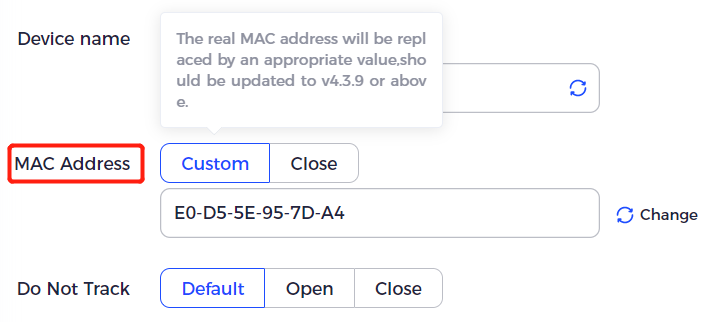How to Hide the MAC Address
What's a MAC address?
MAC address (Media Access Control Address), commonly known as LAN address, Ethernet address, or physical address, is an address used to locate a network device. It can be translated as Media Access Control Address. IP addresses are handled by the Layer 3 network layer in the OSI model, while MAC addresses are handled by the Layer 2 data link layer. A device (such as a computer or cell phone) that requires one or more network cards will each have a unique MAC address, which is used to uniquely identify a network card in a network.
The MAC address is typically written in hexadecimal notation, such as "C0-3C-59-00-81-8C" or "c0:3c:59:00:81:8C", and it consists of 48 bits (6 bytes). The NIC vendor receives the first 24 bits of the address from the IEEE (Institute of Electrical and Electronics Engineers), who utilizes the remaining 24 bits to give each NIC a globally unique global management address. Large merchants frequently buy several OUIs.
Can a third party get my MAC address?
Since MAC addresses are globally unique, all other fingerprinting approaches can be disregarded if the user can be recognized by their MAC address as a fingerprint. However, due to this high recognition, it is difficult for a third party to obtain a user's MAC address.
Here are a few circumstances when MAC addresses can be obtained by other parties.
WiFi
If WiFi is enabled on a smartphone, when a user takes it outside, the device will continuously search for nearby wireless access points (hotspots), and the supplier of the hotspot can use the MAC addresses obtained from these queries to locate the user. A wireless access point called WiFi Probe constantly alerts adjacent WiFi devices to the presence of an access point. The WiFi-enabled gadget will then continuously search for nearby open wireless access points. Even when they are not connected to WiFi, users can identify their devices using WiFi probe technology. These gadgets range from computers to tablets to cellphones.
The industry started randomizing MAC addresses in reaction to MAC address abuse so that users could no longer be tracked. People started adopting randomized scanning in 2014, which also restricted the capacity to follow people. Over time, the genuine MAC addresses of iOS, Android, Windows, and Linux operating systems started to disappear.
Flash plugin
The MAC address of a user can also be obtained using a Flash plugin. Flash plug-ins used to be installed on browsers extremely often, and websites could use them to circumvent the browser and obtain the computer's MAC address. However, this method of gathering MAC addresses rapidly fell short as all major browsers stopped supporting the Flash plug-in as of July 25, 2017, when Adobe Systems announced intentions to phase out the Flash player plug-in at the end of 2020.
Android devices
Only with Android versions prior to 7.0 are users' MAC addresses accessible to third-party application developers for Android phones. However, in earlier versions of Android, applications could call the internal Android interface to obtain the MAC addresses of network devices through reflection and other techniques. However, this method is no longer practical in the latest version of Android. In fact, the Android system does not provide an interface for applications to obtain MAC addresses.
Browser
Another possibility is that the website obtains its MAC address from the browser, however current browsers (Chrome, Firefox, and Edge) do not offer a user-friendly interface for obtaining MAC addresses, therefore the website is unable to do so absent a specially designed browser. Another situation, though, involves the release of additional features by browser manufacturers (like Google), such as data synchronization and safe browsing features. Because this process involves direct server communication between the browser and the server, the browser manufacturer cannot completely rule out the possibility of discovering the user's MAC address.
In conclusion, it can be said that when we browse a typical website, the website cannot determine our computer's MAC address. It's feasible for the browser vendor to discover your MAC address if you connect into your browser to achieve cross-device bookmark, password, and login information synchronization. Google may obtain your MAC address, for instance, if you use Chrome. There is no proof that Google actually obtains user MAC addresses; this is only meant to demonstrate Google's capability to do so.
How to hide my MAC address?
If you frequently bring your smartphone outside, it could leak your MAC address, but if you use a new phone made in the last few years, you shouldn't typically be concerned because the phone usually has the random MAC function switched on by default. Consider shutting off the wifi if you are using an old smartphone.
Most of you who access websites through browsers don't have to worry about them learning your MAC address. But if you're still worried, you might want to use an antidetect browser. Most of antidetect browsers now provide a MAC address setting option that may produce a MAC address at random, ensuring that even if a website obtains your MAC address, it will be a phony address and you won't need to worry about the leak of your actual MAC address.

İnsanlar Ayrıca Okuyun
- Breaking Down What Is A User Agent: UA Components & How To Look It Up
- How to Avoid Browser Fingerprinting: A Comprehensive Guide
- What Are WebRTC Leaks and How to Prevent Them?
- TLS Fingerprinting: Techniques and Bypassing Methods
- Digital Fingerprinting and IP to Integer Conversion: Protecting Your Online Privacy


